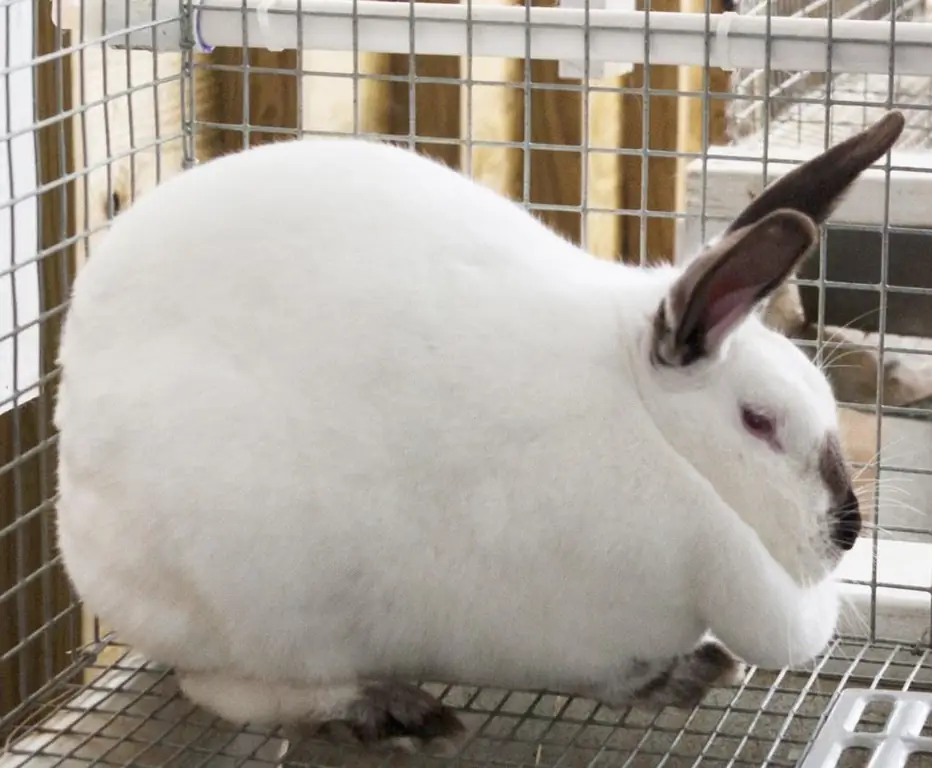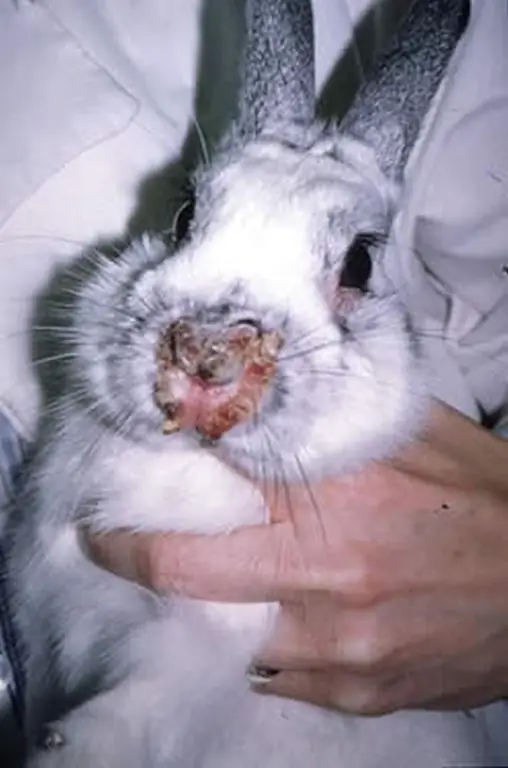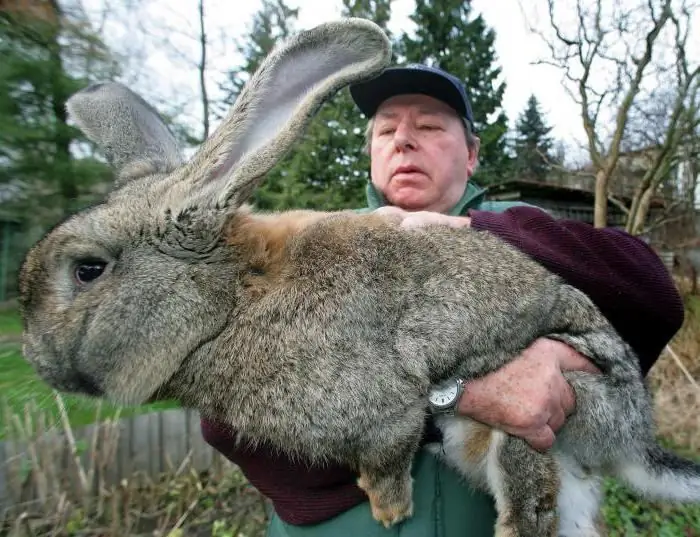2025 Author: Howard Calhoun | [email protected]. Last modified: 2025-06-01 07:12:56
Pododermatitis (colloquially corns) is often found in adults of various species. Wound formation is influenced by various factors. Pododermatitis is severe in rabbits, and treatment is even more difficult. Those who wish to breed this fur-bearing animal need to know how to avoid infection of pets and properly provide them with medical care.
Factors affecting the formation of corns
The appearance of wounds on the paws of rabbits is affected not only by cage fillers, but by a number of factors. These include:
- Lack of hair on the paws of the animal. No additional protection against leather abrasion.
- Great weight of an individual. Stress on the paws leads to ulcers.
- Long claws that deform the paw. An improperly formed gait injures the skin of the paw.
- Insufficient motor activity. Animals that move less are more likely to develop leg wounds.
- Age of the individual. In older individuals, the skin becomes thinner and more prone to injury.
- Improper animal care. Ordinary unsanitary conditions and improper care lead to diseases of the limbs of animals.

First signs of disease
Scaling of the skin of the paws of a rabbit is the first sign of pododermatitis. At the next stage, the hair on the paws begins to fall out. And there are corns in the rabbit. Then there are ulcers that bleed. A staphylococcus or fungus gets into an open wound. The animal loses its appetite, it becomes lethargic and does not get up. If you do not provide urgent assistance, the animal may die.
Stages of the disease
Pododermatitis is purulent and aseptic. The disease develops in stages.
- The initial stage is aseptic pododermatitis in rabbits. Treatment should be started at the stage of the first signs of the disease.
- Surface infection is characterized by peeling. Timely prescribed treatment ends with a quick recovery.
- Superficial wound infection. At this stage, an infection enters the wound, and suppuration appears under the skin. Urgent treatment is needed. As a rule, at this stage the animal is cured.
- Complete wound infection. Ulcers eat away at the skin and soft tissues. At this stage, surgical intervention is indispensable. The prognosis for the life of the animal is positive.
- Deep infection. In this case, the tendons and the skeletal system are affected. The last and most advanced stage. As a rule, it is possible to save the animal inrare occasions.

Treatment of pododermatitis
A common disease is pododermatitis in rabbits, its treatment begins at the stage of flaking and diaper rash. You must contact your veterinarian immediately. As a rule, an antibiotic, ointment and regular dressing are immediately prescribed. Treatment is carried out with the help of medicines:
- Antiseptics. Wounds are disinfected with antiseptics. Treat the paws with hydrogen peroxide, furacilin or chlorhexidine. Washing is carried out several times a day until the signs of the disease disappear completely. If the rabbit's foot is festering, the pus is removed with tincture of iodine (2%). Iodine also has a drying effect.
- Ointments. For the treatment of pododermatitis, wound healing ointments for open wounds are used, the rapid effect of which is obvious. After cleaning the wound, Vishnevsky ointment, zinc ointment (10%), lead ointment are used. The affected areas are smeared with a thin layer. In the evening, you can use "Solcoseryl" or "Levomekol" as an emollient and healing agent. Ointment "Levomekol" - what is it used for? According to the instructions, "Levomekol" is an antimicrobial and wound healing drug. It copes well with various infections, including staphylococci. Well disinfects even festering wounds.
- The use of special dressings is justified. For them, synthetic wool is used, which does not roll. The rabbit is clamped under the arm, head down. The ointment is impregnated with thin gauze flaps with synthetic wool inside and filled with them.wound. Secure with a gauze bandage. The foot is wrapped around, capturing a fairly large area before the fold. This is necessary so that the bandage does not fall off. Bandages are changed 2-3 times a day.
- Powders and sprays. It is good to disinfect open wounds with powder or spray. They are easy to apply and tactile contact with painful skin can be avoided, which will not cause additional pain to the animal. The spray from pododermatitis in rabbits "Ksidikol" has proven itself well. The composition of the spray includes the antibiotic chloramphenicol - a broad-spectrum drug. A popular drug in veterinary medicine. The wounds of the animal are treated with a spray 2 times a day until completely cured. Used in combination with other preparations for open wounds. The quick effect of "Ksidikol" is achieved by instant absorption of the drug. Small particles of the spray get into even the most inaccessible places. For bleeding wounds, it is good to use Dermatol. The powder quickly and painlessly penetrates the wound, disinfecting and drying it.
- Antibiotics. If you have to treat an advanced case, then you can not do without the use of antibiotics. Broad-spectrum agents are often used: Ceftriaxone, Baytril, Lincomycin.
To avoid re-infection, protect the paws from damage and prevent the animals from licking the drugs, bandages are applied to the paws. They are changed daily, and in advanced cases up to 3 times a day.
In especially neglected cases, it is better to euthanize the animal. Firstly, it will save him from suffering, and secondly, from disability. Life is saved only for the most valuablebreeds if there is an economic benefit.

How flooring affects the formation of pododermatitis
Pododermatitis in rabbits is difficult and painful - treatment is a troublesome and costly process. Often animals die, unable to cope with the disease. The task of the owner is to prevent the appearance of corns in animals and protect them from a long illness, and save themselves from unnecessary and unnecessary trouble.
One of the main factors provoking the appearance of the disease is the hard surface of the cage where the animals are kept. Irregular cleaning, changing flooring and hard floors cause open wounds. The ideal flooring is a thick layer of straw that needs to be changed regularly. If it is not possible to make flooring from straw in the cage, a ladder is installed for rabbits from pododermatitis.

What is the design of the ladder
A rabbit ladder is often a plastic or wooden ladder with a ribbed or mesh surface. Installed at the bottom of the cage. It works on the principle of a massager - an uneven surface does not allow venous blood to stagnate in the paws of the animal, and prevents the appearance of ulcers and corns. Among other things, constant physical activity has a fat-burning effect, which is important for the rabbit's body.
Prevention of pododermatitis
The main goal of the rabbit farm breeder is to provide all the necessary conditions for a comfortable stay for pets. Pododermatitis in rabbits and the treatment of this disease is notwill overshadow the life of a rabbit breeder if you follow the simple rules for keeping these animals.
You need to choose the right bedding. The flooring must be rigid and absorb moisture well. In addition to straw, various types of industrial granulates can be used. Absorbent granules are well mixed with sawdust - you get the perfect coating.
Categorically do not use a variety of carpets, stone, hard surfaces. Such types of coverage will inevitably lead to paw disease. Also, do not use all types of linoleum and palm fiber bedding.

Diet
Rabbits should be fed all the necessary nutrients and vitamins. The diet should be rich in fiber. It is good to use vegetables in the diet, such as carrots, cabbage. It is necessary to purchase special vitamin supplements designed specifically for these animals.
There should always be clean fresh water in the drinking bowl, but not boiled. It is not very useful for this beast. Also, some experts advise buying special vitamin supplements for your pet that are water-soluble, such supplements can be purchased at veterinary stores.

Hygiene
Cleanliness is the key to he alth. This Soviet-era slogan is perfectly applicable to keeping rabbits. Moisture, dirt, excrement residues will inevitably lead to the appearance of various diseases, not only pododermatitis. Cages are cleaned every day.
Once aa week to carry out general cleaning. The cage is washed with hot soapy water. To eliminate moisture on the floor of the enclosure, it is good to use cat litter. it is worth making wooden flooring on the floor of the cage. Every time after the general cleaning, in order to prevent the appearance of fungi and staphylococcus aureus, the boards are treated with lime.
Vaccination and quarantine
Young livestock must be vaccinated against all diseases. Animals are vaccinated at the age of over 45 days. When buying a new livestock, quarantine must be observed. These animals are kept in individual cages for 30-45 days. If diseases are not detected, it can be planted with the main livestock. Sick animals are isolated.

Prevention using folk methods
If the first signs of pododermatitis appear on the paws of a rabbit, you can use calendula tincture to treat abrasions. Take 1 tablespoon of calendula flowers and steam with a glass of boiling water. Process corns several times a day until complete healing.
In the diet, you can add strawberry leaves, shepherd's purse, plantain leaves.
In case of deterioration, use wound healing ointments for open wounds, the quick effect of which will not let the situation get out of control. Pharmaceutical products are often faster and more effective in dealing with infections. It is good to have Levomekol ointment on hand. What it is used for - the instruction describes all indications.
Breeding rabbits is an interesting but troublesome activity. If you create all the necessary conditions for animals, properly care for and treat them, monitor the slightest changes in behavior and nutrition, you can get a he althy, full-fledged livestock that will become the pride of its owner and will not bring additional troubles associated with he alth and care. If rabbit breeding is a business, then proper care will save on medicines and veterinary services.
Recommended:
Can rabbits eat wheat? Features of the care and feeding of rabbits, diet, tips and tricks

Experienced rabbit breeders know that if rabbits are properly cared for, almost all diseases can be avoided. One of the keys to good he alth is good nutrition. Before you start rabbit breeding, you should carefully study what can be given to rabbits and what is strictly prohibited
Diseases of rabbits: symptoms and their treatment. Disease prevention in rabbits

Rabbit diseases can destroy most of the livestock in a matter of days. In order to provide assistance to animals in time, it is necessary to be able to determine the disease, as well as vaccinate in time, follow the rules of care
Retention of the placenta in cows: causes, signs, treatment, drugs

Retention of the placenta in cows is a very dangerous phenomenon. Assistance to the animal in the event of such a problem should begin to provide as soon as possible. Otherwise, the cow may have sepsis, which will lead to her death
Expensive treatment: list for 3 personal income tax. What is expensive treatment?

Tax legislation provides that when paying for medicines, you can recover part of the funds by issuing a tax deduction. This opportunity is available to officially employed persons (from whose income personal income tax is paid), who pay for treatment for themselves or their relatives. For more information on how to apply for a tax deduction for expensive treatment, a list for 3-personal income tax documents, read on
Breeds of rabbits with photos and names. Giant rabbits. Meat breeds of rabbits

The rabbit was tamed by man a long time ago. This is mentioned in the written sources of ancient Roman history. From that time to the present, many new breeds have been created by rabbit breeders. Rabbits are bred to obtain dietary meat, fur, fluff. Fur products are highly durable, and the quality of the down prevails over the wool of the merino and angora goats. This article will present rabbit breeds with names and photos

